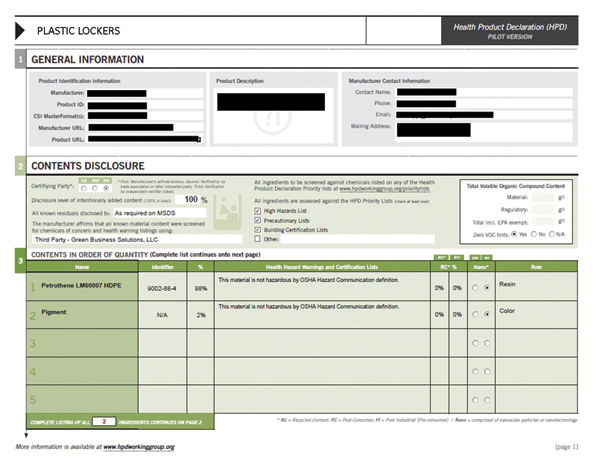This CE Center article is no longer eligible for receiving credits.
Contains Recycled Content
Beyond being fully recyclable, an HDPE locker can contain products that were recycled, which is also referred to as a recycled-content product. This means that the HDPE locker contains items that have been diverted from the traditional waste stream, allowing used items to be re-used in an HDPE locker, instead of ending up in a landfill. The amount of recycled material in a product is typically stated as a percentage. A higher percentage indicates that more of the total product was created from recycled content.
New trends in green building and sustainable design programs are placing a growing emphasis on identifying the stage of use at which the product was sent to become recycled content. This has created different types of recycled content. Most commonly, recycled content is categorized as either post-consumer recycled content or post-industrial recycled content.

Photo courtesy of Scranton Products
Post-industrial/pre-consumer recycled content. For either fun or confusion, two interchangeable terms have emerged to refer to material that is being recycled from manufacturing waste. The two terms are post-industrial and pre-consumer. In either case, it refers to a material that essentially became waste in the manufacturing process of another product and, as such, was never used in an end-user capacity.
HDPE lockers typically contain between 25 percent and 75 percent of post-industrial recycled content. This is again significantly higher than the industry average of post-industrial recycled content found in metal lockers which contain, on average, up to 28 percent post-industrial recycled content.
No Paints, Coatings, Adhesives, Sealants
HDPE lockers are manufactured from a solid plastic material. These lockers do not employ paints, coatings, adhesives, or sealants of any kind. The solid lockers do not emit or off-gas any volatile organic compounds (VOCs) over the course of their usable life.
Significantly Reduce Interior Noise Pollution
The resounding slam of a metal locker is the soundtrack for many school day memories, but new emphasis on acoustical control in the school environment could incentivize designers to minimize the noise pollution created at the locker. Recent tests measured the noise level created by the normal operation of a metal locker at 81 decibels(dB). To put that into context, the American Tinnitus Association identifies an alarm clock (2 feet away) as having a sound level of 80 dB. Alternatively, the noise level created by the normal operation of an HDPE locker was measured at just over 74 dB. This noise level is considered similar to that created by a washing machine or an average radio volume.
In terms of reducing potential noise pollution in the indoor environment, specifying HDPE lockers in a school corridor, instead of metal lockers would create a material difference. It is the difference between a hallway filled with buzzing alarm clocks or a hallway filled with whooshing washing machines. Renee Rudd, principal, Central Valley Academy High School, Ilion, New York, noticed a significant change in the amount of noise in the hallway after the metal lockers were replaced by HDPE lockers. “Before, the hallways were always filled with the metal-on-metal clatter of the locker doors opening and shutting. Now, you don't hear that. You hear the kids talking and you hear movement in the hallway, but you don't hear the rustle of lockers that you used to hear. It is much better.”
Content Transparency
In the quest to create healthier spaces, designers want to know if a product poses a potential risk to the health and well-being of building occupants. They want to know if a product could negatively affect the interior environment and potentially cause an adverse reaction in a person who comes in contact with a product or spends time in the general area of a product. For example, there are thousands of products currently available for specification that emit VOCs, some of which, according to the Environmental Protection Agency (EPA), may have short- and long-term health effects. Designers want to be able to consider the potential health impact of a product, before it is specified into a building they are designing.
In response to these rumblings, another aspect of sustainable design gaining momentum is the demand to improve visibility to the potential health impacts that a product may have on building occupants. Non-profit organizations and manufacturers are developing health disclosure tools that highlight the potential impact a product may have on human health and well-being. One of the first health disclosure tools on the market was the Health Product Declaration™ (HPD).

Photo courtesy of Scranton Products. Danville Elementary School, Danville, PA.
Both the HDPE resin and the pigment ingredients in an HDPE locker have been classified as not hazardous by the OSHA Hazard communication definition.
The HPD contains an itemized list of the ingredients contained within a product and communicates whether or not any particular ingredient has been identified as hazardous or of concern. It should be noted that while the HPD attempts to convey whether or not the product contains any ingredients identified as hazardous, it stops short of addressing whether or not the use of a chemical in a product represents a meaningful risk to the people or the environment. This is an important distinction to make, because it is possible for a product to contain a hazardous material, but present no real risk to the health or well-being of the people manufacturing the product or the finished interior that contains the product. Nonetheless, the HPD does provide improved product transparency in terms of presenting the product contents and is a tool that specifiers, design teams, and building owners can use to make more informed decisions in choosing building products that contribute toward creating a quality interior environment and promoting the health and well-being of its occupants.
Health Product Declaration (HPD). In November 2012, the first open standard format for reporting content and hazards in building products was launched by the Health Product Declaration Collaborative. The Health Product Declaration™ (HPD) Open Standard Version 1 is a standard format that building manufacturers can use to convey the details about hazardous product content, emissions, and associated health information needed by building designers, specifiers and owners to make more informed decisions during product selection.

The HPD gives specifiers visibility into the contents of a product and the potential impact that those ingredients may have on the health and well-being of building occupants.
The HPD is designed to improve the transparency of product contents and facilitate conversations between manufacturers and the specification community about the impact that material selection can have on the quality of the interior building environment and the health of its occupants. The standard reporting format reduces redundant, and sometimes conflicting, reporting formats that product manufacturers have been managing, provides a clear definition of what constitutes disclosure of product contents, and assists interested parties in comparing the formulations of different products.
While still relatively new to the building industry, an HPD can already be used to satisfy various green building initiatives and is gaining traction in the design and specification community as an important resource to reference when considering which products to specify onto a project. The HPD has been identified as an acceptable pathway for the “Building Product Disclosure and Optimization-Material Ingredients” credit in the green building rating system LEED™ v4, as approved by USGBC members.
HPDs are increasingly being required by design firms, finished product manufacturers, architects and builders, with some members of the design community mandating that products in their library or included in their projects must provide full content transparency.
HPD report contents. A product HPD is comprised of five sections: general product information, product content in descending order of quantity, applicable testing and certifications, accessory materials, and notes. The fundamental purpose of the HPD is to give visibility to the contents of a product and the health hazards associated with those ingredients. The report recognizes two types of contents: intentional ingredients and residuals. Intentional ingredients are defined in the HPD Standard as each discrete chemical, polymer, metal, bio-based material or other substance added to the product by the manufacturer or suppliers that exist in the product as delivered for final use. Residuals that should be disclosed are defined in the HPD Standard as known trace substances remaining in the product from manufacturing steps or contaminants that come with raw materials. This may include residuals known from testing as well as those estimated as likely from assessment of process chemistry.
In an HPD, there is an entry line for each intentional ingredient and residual, essentially creating an inventory of the product contents. Standardized reporting elements for each ingredient include: substance name, the Chemical Abstract Service Registration number, also referred to as the CAS number, the ingredient's percentage of the final product by weight, GreenScreen® benchmark, recycled content, whether or not the product is comprised of nanoscale particles or nanotechnology, and the role or function of the ingredient in the product.
Each ingredient and residual is then screened for health and environmental hazards against a minimum set of authoritative chemical hazard lists defined as the HPD Priority Lists. The HPD Priority Lists are comprised of the chemical hazard lists that inform the GreenScreen® for Safer Chemicals methodology and includes lists that address ozone depletion, global warming, pollution, and halogenated flame retardants. Any health hazards, warnings, or appropriate GreenScreen Benchmark abbreviations identified from these authoritative lists must be listed next to the ingredient in this section in the HPD.
The HPD of HDPE. HPDs for HDPE products have been completed by third-party certifiers providing full disclosure of product contents and finding that the HDPE ingredients do not pose any known health hazards and do not require a warning of any kind.
An HDPE product, such as an HDPE locker, may have as few as two intentional ingredients to list in the HPD. They are the specific HDPE plastic used as the resin for the product and the pigment used to color the product. Once the ingredients have been identified and listed on the HPD, the certifying party will then assess the listed product ingredients against multiple HPD priority lists identifying compounds that have been shown to be potentially hazardous.
HDPE resin does not appear on any of the authoritative lists referenced to identify hazardous compounds and, subsequently, the HDPE resin is classified as non-hazardous. Specifically, per the HPD Collaborative, HDPE resin is classified as “hazard range low” for GreenScreen Group I Human Health Effects, which evaluates ingredients for carcinogenicity, mutagenicity/genotoxicity, reproductive toxicity, developmental toxicity, developmental neurotoxicity and endocrine activity. HDPE resin is also classified as “hazard range low” for GreenScreen Group II Human Health Effects, which evaluates ingredients for systemic toxicity/organ effects, including immune system effects, neurotoxicity, respiratory sensitization, skin sensitizations, ecotoxicity, flammability and reactivity.
Some HPDs are completed at a level of disclosure required by a Material Safety Data Sheets (MSDS). An MSDS is a document that contains information on the potential hazards of a product in terms of the health, fire, reactivity, or environmental hazards it may present. It is intended to identify what the hazardous ingredients are, how to use the product safely, and what to do if accidents occur and how to recognize symptoms of overexposure. The Federal Occupational Safety and Health Administration (OSHA) Hazard Communication Standard (29 CFR 1910.1200) requires manufacturers of chemicals to issue MSDSs. In prior HPDs completed for HDPE products, that were completed “as required on an MSDS”, both the HDPE resin and the pigment are described as “not hazardous by the OSHA Hazard Communication definition.”
A school locker is the hub of a student’s school life. As such, it is stuffed, slammed, and personalized multiple times a day, year after year. Considering the regular use and abuse a locker receives throughout its life, it is no surprise that facilities personnel and designers routinely rank durability as the most important feature of this type of product. Unfortunately, the traditional metal locker has material limitations that make it unable to withstand some of the regular wear and tear inherent in a K-12 location. New HDPE lockers offer specifiers a solution that can more successfully survive impacts, weather moisture exposure without rusting, and improve maintenance overhead by allowing graffiti to be easily wiped away. Beyond its durability benefits, HDPE lockers provide considerable support for sustainable design objectives and can contribute toward earning green certifications from some of the premiere school-specific green building rating systems.
The Limited Durability of Traditional Metal Lockers
The traditional metal lockers selected to adorn school corridors for decades are made from 16-gauge powder-coated steel. Despite its prevalence in the K-12 application, this material is not the perfect solution for the space, in large part because the material has some deficiencies that make it unable to hold up to the daily wear and tear of a school environment. Metal lockers may dent when impacted, rust when exposed to moisture, and removing tape and graffiti from the surface can be difficult. Unfortunately, collisions, wet conditions, and locker door drawings are all part and parcel of an average school day, leaving many in the design and maintenance community demanding a better, more durable locker solution than the traditional metal locker.

Photo courtesy of Scranton Products.
HDPE lockers have earned GREENGUARD Gold certification and are recognized as a low-emitting material.
One such demand was heard from Lynne Peterson, executive director, Cologne Academy in Cologne, Minnesota. The charter school was expanding and one of the goals of the Facilities Task Force was to identify alternatives to the traditional metal lockers found in the corridors of the existing buildings. “It has only been five years since the Academy first opened and the metal lockers are already starting to look worn. We wanted to put a locker that would outlast and outperform the metal lockers in the new addition,” explains Peterson.
Dents
Traditional metal lockers are typically less than 1/16 of an inch thick, thinner than a standard copper penny, making the locker panels susceptible to denting and damage from everyday impacts.
Rusting
As most high school chemistry textbooks will reveal, steel rusts when it comes into contact with water and oxygen. For a real world demonstration, many students need not look farther than the base of their locker. Simply pick up the snow boots dripping a melting mess of snow and salt on the bottom panel. This is a first-rate rust-causing concoction that can quickly corrode the locker surface wherever the paint-coat has been compromised.
In September 2011, flooding from Tropical Storm Lee devastated the Danville Middle School in Danville, Pennsylvania. In the aftermath of the storm, the auditorium was 8 feet under water and several feet of standing water were found in most classrooms, hallways, the library, the cafeteria, and the gymnasium. After only a few days, the metal lockers in the hallways were rusting from exposure to the contaminated floodwater and every single metal locker in the school had to be replaced.

Photo courtesy of Scranton Products. Cologne Academy, Cologne, MN.
HDPE lockers have earned GREENGUARD Gold certification and are recognized as a low-emitting material.
Graffiti
The typical painted metal has low resistance to graffiti and attempting to remove ill-placed scribbles is often difficult and can leave a ghosting mark, which continues to compromise the overall aesthetic of the locker and can leave a facility manager with no other choice but to repaint the lockers.
Introducing High-Density Polyethylene (HDPE) Lockers
High-density polyethylene (HDPE) material brings solutions to the durability concerns from both designers and facility personnel. HDPE is one of the most commonly used plastics in the United States. It is regularly found in milk jugs, plastic bags, and yogurt cups. Solid HDPE is used to fabricate the lockers and can also be found in bathroom partitions, shower stalls, and playground equipment.
It is the solid nature of the HDPE used in the locker that gives this product its improved durability. HDPE lockers are made of ½-inch-thick rigid HDPE plastic, more than eight times thicker than the locker panels made of 16-gauge steel.

HDPE lockers were found to be 59 times more impact resistant than a typical metal locker.
In order to quantify the difference in impact resistance offered by both locker materials, tests were conducted according to ASTM International standard D2444 (Standard Test Method for Determination of the Impact Resistance of Thermoplastic Pipe and Fittings by Means of a Tup [Falling Weight]). During these tests, a 100-pound weight was dropped on the traditional metal material and the HDPE material. The weight created a dent measuring 0.292 inches deep in the traditional metal surface and only 0.003 inches deep in the HDPE surface. The dent in the metal surface is more than 97 times deeper than the dent left in the HDPE surface.
Beyond a tougher exterior, the solid HDPE material will never delaminate or need painting because it is a solid piece of plastic that is uniformly colored throughout. The color is physically integrated into the material, not added on top of it at a later stage as a coating or laminate.
An HDPE locker provides an impermeable, non-porous surface that protects the locker from being damaged by water or graffiti. These lockers withstand exposure to moisture without corroding and, because the locker is made from plastic and not iron or steel, exposure to water will not cause the locker to rust. Graffiti wipes off easily with most non-abrasive cleaners. This can significantly reduce the time that facilities personnel must spend maintaining the lockers. As Robert Gannon, director of facilities at Ocean City High School in Ocean City, New Jersey, explains. “Maintaining metal lockers was a nightmare. When we installed HDPE lockers, we cut our maintenance time from three to four weeks to just two to three days. The amount of time spent on cleaning graffiti went from days to minutes. I couldn't be happier.”
It should also be noted that HDPE lockers satisfy the fire rating for school corridors and are NFPA 286 compliant. Select manufacturers offer HDPE lockers that satisfy the fire rating.
Although the HDPE lockers offer widespread benefits to a school application as a result of the improved durability of the product, it is not enough to simply be stronger in today's building products marketplace. Designers are in need of the best product for the application in a package that contributes toward the green or sustainable design objectives of the project.
Sustainability Features of an HDPE Locker
Sustainable design is based around the tenets of creating buildings, schools, and interior spaces that are healthy, comfortable, productive, and environmentally friendly in terms of energy efficiency, materials usage, and even waste disposal. Student lockers made from HDPE contribute toward the goals of sustainable design in multiple ways. From being a fully recyclable product that can, in itself, contain a significant amount of recycled content, to protecting the quality of the interior environment as a low-emitting product and reducing the hallway noise pollution with softer operating noise levels, the HDPE locker solution supports sustainable design goals.
Fully Recyclable
A recyclable product can be remanufactured back into the original product or something else rather than heading for a landfill after its first useful life has ended. HDPE is easily recyclable and can be used again and again. Moreover, recycled HDPE creates no harmful emissions during its production or during its use.

Photo courtesy of Scranton Products. Danville Elementary School, Danville, PA.
Contains Recycled Content
Beyond being fully recyclable, an HDPE locker can contain products that were recycled, which is also referred to as a recycled-content product. This means that the HDPE locker contains items that have been diverted from the traditional waste stream, allowing used items to be re-used in an HDPE locker, instead of ending up in a landfill. The amount of recycled material in a product is typically stated as a percentage. A higher percentage indicates that more of the total product was created from recycled content.
New trends in green building and sustainable design programs are placing a growing emphasis on identifying the stage of use at which the product was sent to become recycled content. This has created different types of recycled content. Most commonly, recycled content is categorized as either post-consumer recycled content or post-industrial recycled content.

Photo courtesy of Scranton Products
Post-industrial/pre-consumer recycled content. For either fun or confusion, two interchangeable terms have emerged to refer to material that is being recycled from manufacturing waste. The two terms are post-industrial and pre-consumer. In either case, it refers to a material that essentially became waste in the manufacturing process of another product and, as such, was never used in an end-user capacity.
HDPE lockers typically contain between 25 percent and 75 percent of post-industrial recycled content. This is again significantly higher than the industry average of post-industrial recycled content found in metal lockers which contain, on average, up to 28 percent post-industrial recycled content.
No Paints, Coatings, Adhesives, Sealants
HDPE lockers are manufactured from a solid plastic material. These lockers do not employ paints, coatings, adhesives, or sealants of any kind. The solid lockers do not emit or off-gas any volatile organic compounds (VOCs) over the course of their usable life.
Significantly Reduce Interior Noise Pollution
The resounding slam of a metal locker is the soundtrack for many school day memories, but new emphasis on acoustical control in the school environment could incentivize designers to minimize the noise pollution created at the locker. Recent tests measured the noise level created by the normal operation of a metal locker at 81 decibels(dB). To put that into context, the American Tinnitus Association identifies an alarm clock (2 feet away) as having a sound level of 80 dB. Alternatively, the noise level created by the normal operation of an HDPE locker was measured at just over 74 dB. This noise level is considered similar to that created by a washing machine or an average radio volume.
In terms of reducing potential noise pollution in the indoor environment, specifying HDPE lockers in a school corridor, instead of metal lockers would create a material difference. It is the difference between a hallway filled with buzzing alarm clocks or a hallway filled with whooshing washing machines. Renee Rudd, principal, Central Valley Academy High School, Ilion, New York, noticed a significant change in the amount of noise in the hallway after the metal lockers were replaced by HDPE lockers. “Before, the hallways were always filled with the metal-on-metal clatter of the locker doors opening and shutting. Now, you don't hear that. You hear the kids talking and you hear movement in the hallway, but you don't hear the rustle of lockers that you used to hear. It is much better.”
Content Transparency
In the quest to create healthier spaces, designers want to know if a product poses a potential risk to the health and well-being of building occupants. They want to know if a product could negatively affect the interior environment and potentially cause an adverse reaction in a person who comes in contact with a product or spends time in the general area of a product. For example, there are thousands of products currently available for specification that emit VOCs, some of which, according to the Environmental Protection Agency (EPA), may have short- and long-term health effects. Designers want to be able to consider the potential health impact of a product, before it is specified into a building they are designing.
In response to these rumblings, another aspect of sustainable design gaining momentum is the demand to improve visibility to the potential health impacts that a product may have on building occupants. Non-profit organizations and manufacturers are developing health disclosure tools that highlight the potential impact a product may have on human health and well-being. One of the first health disclosure tools on the market was the Health Product Declaration™ (HPD).

Photo courtesy of Scranton Products. Danville Elementary School, Danville, PA.
Both the HDPE resin and the pigment ingredients in an HDPE locker have been classified as not hazardous by the OSHA Hazard communication definition.
The HPD contains an itemized list of the ingredients contained within a product and communicates whether or not any particular ingredient has been identified as hazardous or of concern. It should be noted that while the HPD attempts to convey whether or not the product contains any ingredients identified as hazardous, it stops short of addressing whether or not the use of a chemical in a product represents a meaningful risk to the people or the environment. This is an important distinction to make, because it is possible for a product to contain a hazardous material, but present no real risk to the health or well-being of the people manufacturing the product or the finished interior that contains the product. Nonetheless, the HPD does provide improved product transparency in terms of presenting the product contents and is a tool that specifiers, design teams, and building owners can use to make more informed decisions in choosing building products that contribute toward creating a quality interior environment and promoting the health and well-being of its occupants.
Health Product Declaration (HPD). In November 2012, the first open standard format for reporting content and hazards in building products was launched by the Health Product Declaration Collaborative. The Health Product Declaration™ (HPD) Open Standard Version 1 is a standard format that building manufacturers can use to convey the details about hazardous product content, emissions, and associated health information needed by building designers, specifiers and owners to make more informed decisions during product selection.

The HPD gives specifiers visibility into the contents of a product and the potential impact that those ingredients may have on the health and well-being of building occupants.
The HPD is designed to improve the transparency of product contents and facilitate conversations between manufacturers and the specification community about the impact that material selection can have on the quality of the interior building environment and the health of its occupants. The standard reporting format reduces redundant, and sometimes conflicting, reporting formats that product manufacturers have been managing, provides a clear definition of what constitutes disclosure of product contents, and assists interested parties in comparing the formulations of different products.
While still relatively new to the building industry, an HPD can already be used to satisfy various green building initiatives and is gaining traction in the design and specification community as an important resource to reference when considering which products to specify onto a project. The HPD has been identified as an acceptable pathway for the “Building Product Disclosure and Optimization-Material Ingredients” credit in the green building rating system LEED™ v4, as approved by USGBC members.
HPDs are increasingly being required by design firms, finished product manufacturers, architects and builders, with some members of the design community mandating that products in their library or included in their projects must provide full content transparency.
HPD report contents. A product HPD is comprised of five sections: general product information, product content in descending order of quantity, applicable testing and certifications, accessory materials, and notes. The fundamental purpose of the HPD is to give visibility to the contents of a product and the health hazards associated with those ingredients. The report recognizes two types of contents: intentional ingredients and residuals. Intentional ingredients are defined in the HPD Standard as each discrete chemical, polymer, metal, bio-based material or other substance added to the product by the manufacturer or suppliers that exist in the product as delivered for final use. Residuals that should be disclosed are defined in the HPD Standard as known trace substances remaining in the product from manufacturing steps or contaminants that come with raw materials. This may include residuals known from testing as well as those estimated as likely from assessment of process chemistry.
In an HPD, there is an entry line for each intentional ingredient and residual, essentially creating an inventory of the product contents. Standardized reporting elements for each ingredient include: substance name, the Chemical Abstract Service Registration number, also referred to as the CAS number, the ingredient's percentage of the final product by weight, GreenScreen® benchmark, recycled content, whether or not the product is comprised of nanoscale particles or nanotechnology, and the role or function of the ingredient in the product.
Each ingredient and residual is then screened for health and environmental hazards against a minimum set of authoritative chemical hazard lists defined as the HPD Priority Lists. The HPD Priority Lists are comprised of the chemical hazard lists that inform the GreenScreen® for Safer Chemicals methodology and includes lists that address ozone depletion, global warming, pollution, and halogenated flame retardants. Any health hazards, warnings, or appropriate GreenScreen Benchmark abbreviations identified from these authoritative lists must be listed next to the ingredient in this section in the HPD.
The HPD of HDPE. HPDs for HDPE products have been completed by third-party certifiers providing full disclosure of product contents and finding that the HDPE ingredients do not pose any known health hazards and do not require a warning of any kind.
An HDPE product, such as an HDPE locker, may have as few as two intentional ingredients to list in the HPD. They are the specific HDPE plastic used as the resin for the product and the pigment used to color the product. Once the ingredients have been identified and listed on the HPD, the certifying party will then assess the listed product ingredients against multiple HPD priority lists identifying compounds that have been shown to be potentially hazardous.
HDPE resin does not appear on any of the authoritative lists referenced to identify hazardous compounds and, subsequently, the HDPE resin is classified as non-hazardous. Specifically, per the HPD Collaborative, HDPE resin is classified as “hazard range low” for GreenScreen Group I Human Health Effects, which evaluates ingredients for carcinogenicity, mutagenicity/genotoxicity, reproductive toxicity, developmental toxicity, developmental neurotoxicity and endocrine activity. HDPE resin is also classified as “hazard range low” for GreenScreen Group II Human Health Effects, which evaluates ingredients for systemic toxicity/organ effects, including immune system effects, neurotoxicity, respiratory sensitization, skin sensitizations, ecotoxicity, flammability and reactivity.
Some HPDs are completed at a level of disclosure required by a Material Safety Data Sheets (MSDS). An MSDS is a document that contains information on the potential hazards of a product in terms of the health, fire, reactivity, or environmental hazards it may present. It is intended to identify what the hazardous ingredients are, how to use the product safely, and what to do if accidents occur and how to recognize symptoms of overexposure. The Federal Occupational Safety and Health Administration (OSHA) Hazard Communication Standard (29 CFR 1910.1200) requires manufacturers of chemicals to issue MSDSs. In prior HPDs completed for HDPE products, that were completed “as required on an MSDS”, both the HDPE resin and the pigment are described as “not hazardous by the OSHA Hazard Communication definition.”
Sustainability Certifications
In the design and construction industry, the sustainable design benefits of a product have become such an enticing and effective sales pitch that questions of legitimacy have been raised in response to some of the green performance claims being made in promotional materials. Third-party certification programs provide valuable verification services, substantiating aspects of green performance and reducing the opportunity for design professionals to be swayed by false or exaggerated claims of sustainability.
One example where standards and certifications have been developed to measure and substantiate green performance claims is on the topic of VOC emissions. Many green building programs attempt to protect the indoor air quality of a building by minimizing the presence of building products and furnishings that emit VOCs, or, more precisely, that emit VOCs over a certain level that has been determined as acceptable. The dominant standard that defines the acceptable product emission levels and testing practices is the State of California's Department of Public Health “Standard Method for the Testing and Evaluation of Volatile Organic Chemical Emissions from Indoor Sources Using Environmental Chambers, Version 1.1 (2010)”, often referred to as simply CA 01350.
Many building codes and green building rating systems call for the use of products with VOC emission levels that meet the acceptable thresholds outlined in CA 01350. These products are often termed low-emitting products or materials. However, the prevalence of this sustainable design objective has also driven marketers to promote their products and materials as being low emitting. Instead of blindly trusting manufacturer claims, which may be misleading, or spending the time to independently validate the emissions performance of the products under consideration, specifiers could select products that had been awarded a certification validating that the product performs in compliance with the CA 01350 standard.
GREENGUARD certification programs evaluate the VOC emission levels of a product, quantifying the amount of potentially harmful pollutants released into the indoor air by building products, furniture, flooring and cleaners. Products that meet stringent chemical emission limits are certified by GREENGUARD and deemed a low-emitting product. There are two levels of GREENGUARD certification: GREENGUARD and the more stringent GREENGUARD Gold.
GREENGUARD Gold Certification
GREENGUARD Gold certification, previously referred to as GREENGUARD Children and Schools, includes safety factors to account for sensitive individuals such as children and the elderly and ensures that a product is acceptable for use in schools and healthcare facilities, where this more sensitive audience may experience prolonged exposure. In addition to limiting emissions of over 360 VOCs and total chemical emissions, products are certified GREENGUARD Gold if they are found to comply with the requirements of CA 01350.
GREENGUARD Gold certification is referenced by both the Leadership in Energy and Environmental Design (LEED™) green rating system and the Collaborative for High Performance Schools (CHPS).
HDPE Lockers are GREENGUARD Gold Certified
HDPE lockers have earned GREENGUARD Gold certification and are recognized as low-emitting material. VOC emissions from HDPE lockers fall below limits set by CA 01350. These products are deemed safe and appropriate for use in schools and healthcare facilities where sensitive individuals may spend prolonged periods of time.

Photo courtesy of Scranton Products. Cologne Academy, Cologne, MN.
HDPE lockers have earned GREENGUARD Gold certification and are recognized as a low-emitting material.
Green Building Program Contributions
Combine the sustainable attributes of the HDPE locker product, such as recycled content, being recyclable and offering ingredient disclosure forms, with the already attained GREENGUARD Gold certification, and it becomes easier to see how this product could contribute toward multiple sustainable design criteria.
Today, there are many green building rating systems designed to address specific building types. Two of the most prominent guidelines for designing green schools are the LEED v4 Schools rating system and the design practices and criteria provided by the Collaborative for High Performance Schools (CHPS). The HDPE locker product can contribute toward achieving green designations in both systems.
LEED v4 Schools Credit Contribution
The LEED v4 Schools green building rating system, introduced by the U.S. Green Building Council (USGBC), provides a guide for achieving various levels of LEED certification in K-12 schools and buildings used for higher education, addressing the specialized requirements unique to this type of application. The rating system considers various aspects of green building from the sustainability of the site, to water efficiency, energy efficiency, materials use, and indoor environmental quality.
Selecting HDPE lockers for a school corridor can contribute toward earning three of the LEED v4 School credits: Building Product Disclosure and Optimization—Material Ingredients, Building Product Disclosure and Optimization—Sourcing of Raw Materials, and Low Emitting Materials.
Building product fisclosure and optimization—material ingredients. The HPD for the HDPE lockers can serve as documentation for one of the 20 total products that need to demonstrate the chemical inventory of the product under Option 1 of this credit. The intent of this credit is to reward project teams for selecting products for which the chemical ingredients are inventoried using an accepted methodology and for selecting products verified to minimize the use and generation of harmful substances. An HPD is considered an acceptable method for disclosing the inventory of ingredients.
Building product disclosure and optimization—sourcing of raw materials. HDPE lockers are available in a wide range of options that offer different amounts of post-industrial and post-consumer recycled content. Specifying HDPE lockers with recycled content onto a project can contribute toward the total necessary to earn the credit, through Option 2, where at least 25 percent, by cost, of the total value of permanently installed building products on a project satisfy at least one of the responsible extraction criteria such as being a bio-based material, being a wood product certified by the Forest Stewardship Council, containing recycled content, etc.
Low emitting materials. HDPE lockers have earned the GREENGUARD Gold certification verifying that the product emissions are compliant with the requirements of the CA 01350 and that the product is adequately considered a low emitting material. As such, these lockers can contribute toward the 90 percent threshold, by cost, of the low-emitting furniture necessary to satisfy the credit.
Contribution toward the Collaborative for High-Performance Schools (CHPS)
CHPS is a nonprofit organization founded in 1999 as a collaboration of California utilities determined to address energy efficiency in schools. The program quickly expanded to address school design, construction and operation and opened membership up to interested parties outside of the state of California. In October 2014, CHPS launched the latest version of its CHPS Criteria high performance rating system called US-CHPS. This newest version is specifically designed to be used in every state and the District of Columbia, expanding the reach of the program beyond the thirteen state-specific programs that had existed previously.
Even the latest version of the rating system for high performance schools, US-CHPS, contains two credits that focus on the use of low-emitting materials in schools. The credit entitled Low Emitting Materials is a pre-requisite for certification and additional points are available under the credit entitled Additional Low Emitting Materials. The credit offers a few avenues for identifying appropriate low emitting products and materials. One method of compliance is to specify products that are GREENGUARD certified. Specifying GREENGUARD Gold certified products, such as the HDPE lockers, will contribute toward earning these credits.
Student lockers are hardworking pieces of equipment. Unfortunately, the traditional metal locker has material limitations that make it unable to withstand some of the regular wear and tear inherent in a K-12 location. The new HDPE lockers offer specifiers solutions that will more successfully survive impacts, weather moisture exposure without rusting, and improve maintenance overhead by allowing graffiti to be easily wiped away. Beyond its durability benefits, HDPE lockers provide considerable support for sustainable design objectives and can contribute toward earning green certifications from some of the premiere school-specific green building rating systems. Student lockers made from HDPE are really hardworking pieces of equipment.
 |
Scranton Products brands of plastic toilet compartments and lockers have dominated the market for over a quarter of a century, setting new benchmarks for the industry in quality and innovation. Its well-known brands feature the most
durable, low-maintenance, and best products in the industry. www.scrantonproducts.com
|























